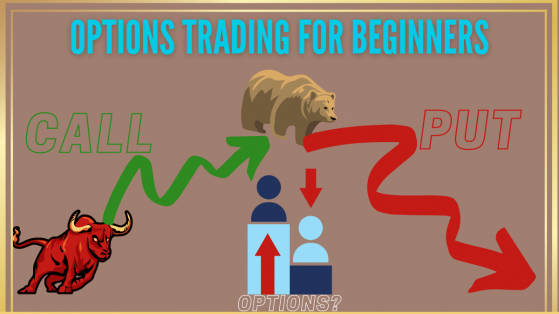Option trading !! Do you want to know what is option trading?
Fine ! Knowing about options trading is a common curiosity that comes to your mind when you get to know a little bit about the stock market.
You know from somewhere (friends, brokers, news channels, etc.) that option trading is the most likely (potential) method of trading other than investment and stock trading.
There is no doubt that option trading is the best in many ways. But option trading is also a double-edged sword. Option trading carries more risk than other assets that are not suitable for everyone. Option trading can make you zero to hero and even hero to zero.
Some people, especially beginners, find some difficulty in understanding option trading. So let’s start learning option trading in an easy way. This will require some more attention.
Another thing you should be clear about is that all the examples of option trading here are only for inference and concept-making. The situation may vary during actual trading.
What is Options Trading?
Image created at: Canva
Option trading, as the name suggests, is a method of trading in an underlying stock or index or commodity where you have the option to invest your money according to your expectations with respect to the underlying stock or index trend.
Expectations are moving up or down the prices of underlying stocks or indices. This allows you to trade in both directions of the market and make a profit.
There are two important points in relation to options trading-
1. What Are Options?
Options are contracts that give the bearer the right, but not the obligation, to either buy or sell an amount of some underlying asset at a pre-determined price at or before the contract expires. Options can be purchased like most other asset classes with brokerage investment accounts. (Source: Investopedia)
Strike Price or Exercise Price – Option contracts are available for the underlying stock or index for different but fixed prices. This price is known as the strike price or the exercise price.
For example, suppose the spot price of the Nifty 50 index is 15000, then option contracts for the Nifty 50 can be available from 13000 to 17000 at a difference of 50 each.
That is, the available strike price above the spot price will be 15050, 15100, 15150 … and so on till 17000. Similarly, the strike price available below the spot price would be 14950, 14900, 14850 … and so on till 13000.
Expiration Date – Each option contract has a fixed expiration date. You must close the status of your option contract on or before this date. In India, the expiration date for option contracts for stocks is monthly, usually the last Thursday of the month.
While option contracts for the index are available in two formats, one is weekly and the other is monthly. The weekly option contract usually ends on Thursday of the week.
And monthly contracts on the last Thursday of the month. If there is a holiday in the stock market on Thursday, the option contract expires on Wednesday.
Lot Size – All options for any underlying asset are available as contract lots. You cannot buy it in single form like shares. Lot sizes for options trading are decided by stock exchanges.
For example, a lot of nifty contains 75 quantities. If you buy the options (call or put) of RIL, you will get 505 shares in one lot.
Options Premium – It is the product of the quantity of shares in a lot of a contract and the price of an option contract. This is the total amount you pay when purchasing a call option or a put option.
2. What Is Meant By Options Trading?
Since in the option trading, an option confers rights and not obligations to the buyer (holder) of the option contract. Hence a call option provides the right to buy while a put option provides the right to sell the underlying asset.
To understand the meaning of options, as a novice you must know in what sense the option contract is exercised as a right. Suppose you already have 100 shares of stock valued at Rs 250.
Now you buy one lot (100 shares) of the put option of that stock at 250 strike price for two months which gives you the right to sell 100 shares for Rs 250 without obligation.
For this, you have to pay an option premium of Rs 500 (assume). Now two months later three conditions are possible.
Case 1– There is no change in the current market price (CMP) of the stock. In this situation you do not incur any loss on your stock investment and lose only a small amount for a put option premium of Rs 500 you paid two months ago.
Conclusion- You are not bound to exercise your right to sell 100 shares.
Case 2– If the share price rises to Rs 260. Now you have a profit of 1000 rupees [(260–250) × 100] on your stock investment. But then the value of the put option will be zero.
If you decide not to exercise the put option, your net profit will be Rs 500 (profit on stock investment – premium paid for a put option).
Conclusion- Again you are not bound to exercise your right to sell 100 shares.
Case 3– If the stock price falls to Rs 220. This is the time when you should exercise the put option contract. You are not obliged to sell at CMP of Rs 220 whereas you have the right to sell 100 shares at Rs 250.
The loss on your stock investment is Rs 3000 if you decide not to exercise the option contract. But if you exercise the put option at Rs 250, you will lose only the option premium paid (Rs 500).
This is the true meaning of option trading where for a small amount of the option premium, a person can effectively insure himself against all possible losses incurred up to the expiration date.
Hope you understand the story of exercising an option contract. Now you will be clear that if you buy a stock option contract (either call or put), then the terms of the standardized contract give you the right to exercise the position of your stock option contract at any time between the purchase date and the expiration date.
If you want to exercise the options contract then it is your right. But you are also not obliged to exercise if you find the contract preferable not to exercise.
Right from the beginning, options are efficient mechanisms that help eliminate risk on underlying assets and reduce risk in both directions.
In fact this financial instrument was derived from securities for hedging of funds during stock investment. Hedging means protecting your own invested capital.
The example described above would be helpful in understanding hedging. This is still the basic concept behind options trading. But apart from this there are many options trading strategies which provide you the opportunity to make a profit.
But nowadays options trading is rarely used by traders for hedging (especially by small traders). But then a natural question arises that instead of trading options trading, why not invest in stocks or do future trading.
Why Options Trading?
There are many reasons to trade in option trading.
In the Indian stock market, you cannot short sell shares for more than a day. However, this rule varies in the US stock market or may differ in other global markets. But in India, if you sell the stock first then it is necessary to square off (buy) the shares in intraday before the market closes.
This means that you cannot hold positions overnight during stock trading in a bearish market. However, futures trading allows you to hold short positions overnight for a fixed period. But again it requires a lot of money in the form of margin money.
But when you do option trading, the problems mentioned above are reduced. If you buy the put option of a stock (which is equivalent to short-selling), you can hold it until the expiry date.
The most important advantage of trading options is that it requires less capital which is about 2% of the total cost of the contract (premium). I think this is the main reason for its popularity among traders.
If you try to buy a large number of shares of a company, then you have to spend a lot of money for this. But if you choose option trading in that stock, then you have to pay a fraction of the money.
Let us understand this with an example.
Suppose you want to buy 505 shares (1 lot) of Reliance Industries Limited at the current market price of Rs 2000. It will cost you 1,010,000 rupees (ten lakh ten thousand). Since if you want to buy 505 RIL quantity then it requires a large amount.
So it would be better for you to buy the call option of Reliance Industries Limited, if you expect the price of Reliance stock to rise. And for call options you will have to pay a little token money (premium) of roughly Rs 20,200 (about 2% of the total cost).
That is, the strike price of 2100 option price is 40 rupees (20,200 ÷ 505). In this way, you can get the same benefit through options trading, for which you have to invest one million rupees in stocks.
Types of Options Trading
By now you must have understood that in option trading you have both options at the same time that you choose long or short according to your expectations. And so there are two types of options-
Call Options
These are the types of options that are used to buy if you expect the underlying price to go up. That is, call option is used in the sense of positive market. But you can also sell call options if you think the price is going to be low.
Put Options
These are the types of options that are used to buy if you expect the underlying price to go down. That is, put option is used in the sense of negative market. But if you think the price is going to increase, then you can also sell the put option.
Options for you in Options Trading
It is clear from the above definition that you can buy or sell call options and similarly you can buy or sell put options.
In the world of option trading, there are two sides at a time. If someone buys the option-contract, then there must be someone who sells it. The position you create during trading is called-
Long Call – when you buy a call option
Short Call – when you sell a call option
Long Put – when you buy a put option
Short Put – when you sell a put option.
You as a options Trader
1. Options Buyer or Options Holder – If you buy either a call option (long call) or a put option (long put), you are known as an option buyer or option holder. Specifically call holders and put holders.
2. Options seller or Options writer – If you sell a call option (short call) or put option (short put), you are called an option seller or option writer. More specifically Call Writer and Put Writer.
Please don’t get confused. This table will clear all four situations –
| Your position | Your view | Remarks |
| Buy a call/Long Call/ Call Holder | Bullish/ Positive view | 1. You pay call premium 2. You have right to buy shares |
| Sell a call/ Short Call/ Call Writer | either a little bit Bearish or neutral | 1. You receive call premium 2. You are obliged to sell shares if the call buyer exercises |
| Buy a put/ Long Put/ Put Holder | Bearish/ Negative view | 1. You pay put premium 2. You have right to sell shares |
| Sell a put/ Short Put/ Put Writer | either a little bit Bullish or neutral | 1. You receive put premium 2. You are obliged to buy shares if the put buyer exercises |
Conclusion
In my opinion, it would be wrong to start in the stock market by option trading. If you are a beginner, read and understand about the market. Do not trade but invest. And yes! If you have experience in the stock market, you can trade options with the help of technical analysis using best technical indicators such as VWAP.
In short term trading such as options trading and intraday trading, it can be a boon for you to learn the stock market calculator and how to use it. Try to learn.
Your feedback matters. Please comment where improvement is needed.


![Options Trading Explained with Examples for Beginners [2023] 1 Options Trading](https://subhmantra.com/wp-content/uploads/2021/05/20210512_212036_0000.png.webp)




